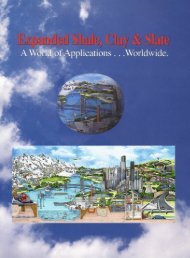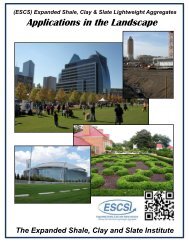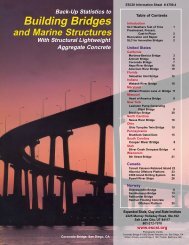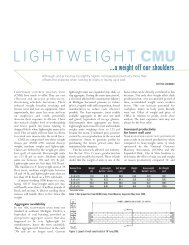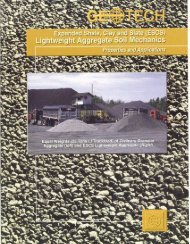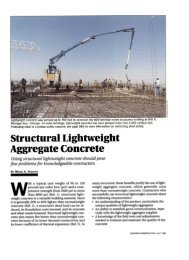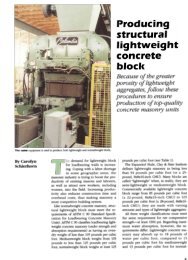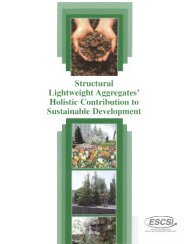Moisture Dynamics in Lightweight Aggregate and Concrete
Moisture Dynamics in Lightweight Aggregate and Concrete
Moisture Dynamics in Lightweight Aggregate and Concrete
You also want an ePaper? Increase the reach of your titles
YUMPU automatically turns print PDFs into web optimized ePapers that Google loves.
Exp<strong>and</strong>ed Sha/eC/ay & S/ateInstitutePublication # 9340February 2004<strong>Moisture</strong> <strong>Dynamics</strong> <strong>in</strong> <strong>Lightweight</strong> <strong>Aggregate</strong> <strong>and</strong> <strong>Concrete</strong>T.A. Holm, P.E., FACI .0.8. Ooi, P. Eng. .T. w. Bremner, Ph.D., P.Eng, FACISynonsis: This paper evaluates the moisture dynamics <strong>in</strong> lightweight aggregates <strong>and</strong> structurallightweightconcrete. The time related changes <strong>in</strong> the moisture contents of aggregate <strong>and</strong> matrix fractions<strong>in</strong> the lightweight concrete were <strong>in</strong>vestigated while exposed to moist-cur<strong>in</strong>g <strong>and</strong> air-dry<strong>in</strong>g.Methodology <strong>and</strong> term<strong>in</strong>ology essential for the determ<strong>in</strong>ation of the particle density, the porosity <strong>and</strong>the absorption characteristics of structural lightweight aggregate are presented. The effects of theseproperties on the batch<strong>in</strong>g <strong>and</strong> freez<strong>in</strong>g <strong>and</strong> thaw<strong>in</strong>g resistance of lightweight concrete are reported.When tested by the procedures of ASTM C666, concretes exposed to seven days of moist-cur<strong>in</strong>g <strong>and</strong>provided with five days of air-dry<strong>in</strong>g at 23°C <strong>and</strong> 50% RH developed a relative durability factor ofover 100% after 300 cycles of freez<strong>in</strong>g <strong>and</strong> thaw<strong>in</strong>g.Ke~ords:absorption, air-dry<strong>in</strong>g, freez<strong>in</strong>g <strong>and</strong> thaw<strong>in</strong>g, lightweight aggregate,lightweight concrete, moisture, pore structure, saturationAUTHORS' BIOGRAPHIESThomas A. Holm, P.E., FACI is the Director of Eng<strong>in</strong>eer<strong>in</strong>g of the Exp<strong>and</strong>ed Shale, Clay <strong>and</strong> SlateInstitute, Richmond Virg<strong>in</strong>ia. He is also the past-cha<strong>in</strong>nan of ACI Committees 213 <strong>and</strong> 122. He has publishedmore than 40 papers on concrete, masonry, thenno-physical <strong>and</strong> geotechnical issues, <strong>and</strong> is the coauthorof the Corps of Eng<strong>in</strong>eers' State-of-the-Art Report on High-Strength. High-Durability. Low-Density <strong>Concrete</strong> for Applications <strong>in</strong> Severe Environments .Oon-Soo Ooi, P.Eng. is Materials Eng<strong>in</strong>eer with Levelton Eng<strong>in</strong>eer<strong>in</strong>g, Ltd., Vancouver, Canada. He hasa total of 15 years of experience <strong>in</strong> concrete design <strong>and</strong> technology, <strong>and</strong> repair <strong>and</strong> rehabilitation of concretestructures. He earned his B.Sc.E. <strong>and</strong> M.Sc.E. at the University of New Brunswick, Canada. He isa member of ACI Committees 121 <strong>and</strong> 515.T. W. Bremner, Ph.D., P.Eng, FACI is an Honorary Research Professor of Civil Eng<strong>in</strong>eer<strong>in</strong>g at theUniversity of New Brunswick, New Brunswick, Canada, <strong>and</strong> is the Past President of the Atlantic Chapterof ACI. He received the ACI Cedric Willson Award for Research on <strong>Lightweight</strong> <strong>Concrete</strong>, <strong>and</strong> is the pastChair of ACI Committee 122, Energy Conservation, <strong>and</strong> 213, <strong>Lightweight</strong> <strong>Aggregate</strong> <strong>and</strong> <strong>Concrete</strong>This paper was presented at the Professor 7: W Bremner Symposium on High Performance <strong>Lightweight</strong><strong>Concrete</strong> at the Sixth Internationa/ Conference on the Durabi/ity of<strong>Concrete</strong>,Thessa/oniki, Greece, June 2003Exp<strong>and</strong>ed Shale, Clay <strong>and</strong> Slate Institute (ESCSI)2225 E. MUITay Holladay Road, Suite 102 .Salt Lake City, Utah 84117801-272-7070/ FAX: 801-272-3377www.escsi.org .e-mail to: <strong>in</strong>fo@escsi.org
~[0]~s!sAI~ a~ JO UO!S!~ald a~ S~!W!I sn~ 'aAa!S a~ ~noR1:Jpas~d q~rqM a}~SaJSS~ }~!ah'4~!1 paqsnl~ JO sa~~ apnl~U! osl~ PJn°~ UO!}~ElJ X!J1~m srq.l.a}al~UO~ JO UO!}~~lj X!J1~m a~ ure:Jqo 0}(SU!Uado aAa!S mm 89.I)aAa!S 01 # W.lSV~ SU!sn paAa!S alaM a}al~UO~JO sa~a!d Ua){01q atU~la~qaSpals ~ SU!sn paqsru~ alaM SlapU!IA~ a}al~UO~ mm 0~1 x mm ~L atU:SMOIIOJ ~ S~M pasn ampa~01d aq.l .SU!AJp-l!~p~ SU!ln~-}S!Om JO saS~ Sn°!I1!A SU!MOIIOJ Sa}al~UO~ a~ U! SUO!}~ElJ X!J1~m p~ Sa}~SalSS~ a~ JO }Ua}UO~aJn1S!Om a~ SU!lnS~am Aq pa}~S!:JSaAU! alaM a}al~UO~ a}~SaJSS~ }~!ah'4qS!1 a~ U! s~!urBuAp aJn1S!Om aq.lJuaJuo:) a.lDJsJoJi\I SUJuJm.laJaa JO poqJaJi\I,.'l ~Iq~.L U! Uh\oqs ~Ie SUO!:JJOdOld ~ln:JX!W ~1~l:>UO:>~q.L .S1S~1 gU!h\~ pm gU!z~~lJ ~tp lOJ sws!ld ww OOv x mw 001 x ww ~L pm 'S1S~1 :>!W"eUAp ~ln:JS!OW" ~tp lOJ Sl~PU!IA:> ww O~Ix mw ~L 01U! 1~:> ~l~h\s~ro1X!W ~1~l:>UO:> ~q.Lsuo».lodo.ld ;}.lnJx!w ;}J;}.lJUO3" ;}lqB.L.%tZS~M a:J~8a188~ :Jq8!aM-:Jq8!1 aq:J Jo :Jua:Juo:) aln:J-S!OW a~ .a:J~8al88~ auy:Jq8!aMl~Wlou q:J!M pasnpUB UO!:J~ln:J~S JO aa18apq8!q ~ O:J pauopwuo:) S~M:J~q:J SJS3: WOlJ pa:)npoldalaM SalmX!W a:Jal:)UO:)a:J~8a188~ :Jq8!aM:Jq8!'lsuo!:J.Iodo.ld ;).In:JX!W ;):J;).1"Juo:)uo!s.I3mmI .I;}JBM JO S.lB;}A , ~U!.lnpS;}JB~;}.1~~V Jq~!;}A\Jq~!'I ;}S.IBO;) JO Jq~!;}M Aq uopd.Iosqv .I;}JBM : I .~!.isAvato ~ ~O ~ 0 ~ ~"- I I I I I I I I I I I O9~~~J4'"'--/ 0&-9~z~G' ~'UO!SlaUIW1 JOsa~~ SnO~A :J~ Sa:J~~al~~~a~Jo U°!l~~SJO aat3apaq:J Sap!AOld I alq~.LpU~ 's:Jsa:J UO!:JdJosq~Jo S:JInsal a1:I'J SM.oqs I .~!d9f:
.Thecoarse aggregates were manually separated from the rema<strong>in</strong><strong>in</strong>g concrete pieces us<strong>in</strong>g a14 oz. hammer;The matrix <strong>and</strong> coarse aggregate fractions <strong>and</strong> the rema<strong>in</strong><strong>in</strong>g concrete mixture were eachweighed <strong>and</strong> oven-dried separately to determ<strong>in</strong>e their moisture contents.Any free water present on the surface of the concrete cyl<strong>in</strong>ders was towel-dried prior to crush<strong>in</strong>g. Theentire crush<strong>in</strong>g <strong>and</strong> separation procedure took approximately 15 m<strong>in</strong>utes to complete. Precautions weretaken to prevent the specimens from dry<strong>in</strong>g dur<strong>in</strong>g this time.PHYSICAL PROPERTIES OFSTRUCTURAL LIGHTWEIGHT AGGREGATEParticle DensityStructural <strong>Lightweight</strong> <strong>Aggregate</strong>s (LA) have a low particle density due to their <strong>in</strong>ternal cellular pore systern.The cellular structure with<strong>in</strong> the particles is developed by heat<strong>in</strong>g certa<strong>in</strong> raw materials to high temperaturesto the po<strong>in</strong>t of <strong>in</strong>cipient fusion, at which time gases are evolved with<strong>in</strong> the pyroplastic mass,caus<strong>in</strong>g expansion that is reta<strong>in</strong>ed upon cool<strong>in</strong>g. Strong, durable, ceramic lightweight aggregates conta<strong>in</strong>a relatively uniformly distributed system of pores that have a size range of approximately 5 to 300 ~enveloped <strong>in</strong> a high-strength vitreous phase. Pores close to the surface are readily permeable <strong>and</strong> fill with<strong>in</strong>the first few hours of exposure to moisture. Interior pores, however, fill extremely slowly, with manymonths of submersion necessary for complete saturation. A fraction of the <strong>in</strong>terior pores are essentiallynon <strong>in</strong>terconnected <strong>and</strong> may rema<strong>in</strong> unfilled after years of immersion.The particle density of an aggregate is the ratio between the mass of the particle material <strong>and</strong> the volumeoccupied by the <strong>in</strong>dividual particles. This volume <strong>in</strong>cludes the pores with<strong>in</strong> the particle, but does not<strong>in</strong>clude voids between the particles. In general, the volume of the particles is determ<strong>in</strong>ed from the volumedisplaced while submerged <strong>in</strong> water. Penetration of water <strong>in</strong>to the aggregate particles dur<strong>in</strong>g the test islimited by the aggregate's previous degree of saturation.The oven-dry density of an <strong>in</strong>dividualparticle depends both on thedensity of the solid vitreous material<strong>and</strong> the pore volume with<strong>in</strong> theparticles, <strong>and</strong> generally <strong>in</strong>creaseswhen particle size decreases. Afterpulveriz<strong>in</strong>g <strong>in</strong> a jar mill over anextended period, the relative densityof the poreless, solid ceramicmaterial was determ<strong>in</strong>ed to be 2.60by methods similar to those used <strong>in</strong>measur<strong>in</strong>g the relative density ofcement.Fig 2. Schematic of Dry Structural <strong>Lightweight</strong> <strong>Aggregate</strong>Absorption CharacteristicsDue to their cellular structure, lightweight aggregates absorb more water than their ord<strong>in</strong>ary aggregatecounterparts. Based upon a 24-hour absorption test conducted <strong>in</strong> accordance with the procedures ofASTM C 127 <strong>and</strong> ASTM C 128, structural-grade lightweight aggregates will absorb from 5 to more than25 percent moisture by mass of dry aggregate. By contrast, ord<strong>in</strong>ary aggregates generally absorb less than2 percent of moisture. The important dist<strong>in</strong>ction <strong>in</strong> stockpile moisture content is that with lightweight
[0].gU!ln:) I~W~~U!p~pu~~x~ lOJ s~~~g~1Sg~ ~qg!~h\'Jqg!I U! l~~~M p~qlOSq~ JO ~IOl ~~ Uo I~~P U! p~~u~wwo:) 'UO!~!PP~ U!'OqM '(8) l~g~!DI In~d f.q L~61 U! P~tlOd~l ~M 'S~~~g~lgg~ JIf.J'1aMlvlU.Lou P~~~lm~S Jo ~sn ~~ f.q ~Iq!ssod~p~w SU!'Bg tp:3u~IJS Wl~~ guoI p~/I.oldW! JO UO!~~~u~urn:)Op ~SlTj ~q.L .S~p~:)~p lnOJ ~~ ~lOW lOJ UMOffi{u~~q ~q gU!ln:) I~W~~U! lOJ ~Iq~I!~/I.~ ~M (l~~~M f.q p~!dn:):)o ~urnI°/I. ~lod I~W~~U! Jo ~u~:)l~d) UO!~~lm~SJO ~~lg~P q'B!q ~ ~!M p~q:)~~q V'1 ~~ U! ~lmS!OW p~qlOSq~ ~~~ ~:)~J ~q.L .~OS moq-v'l ~ U! p~/I.~!tJ:)~ ~~~JO SS~:)X~ U! S! gU!X!W JO ~W!~ ~~ ~~ V'1 JO ~U~~UO:) ~lmS!OW ~~ U~qM ~/I.!~:)~JJ~ f.IIeIn:)!~d S! "gu!ln:) I~u-l~~U!"JO ss~:)old S!q.L .~~~g~lgg~ ~qg!~h\'Jqg!I ~q~Jo s~lod ~q~ U!~!M l~~~M p~qlOSq~ JO l!°AJ.~S~l P~S~~I~lf.IMoIs ~~ wolj ~Iq~I!~/I.~ ~lmS!OW f.q P~P!/I.Old UO!:J:)roJ SnO!~!~U~W~:) ~~ JO UO!~~f.q l~U~q S! UO~~l~q.L .VN ~!M ~~ m~ l~~~~lg S! V'1 gU!U!~UO:) ~~~l:)UO:) JO f.:J!{'Iffib ~~ U! ~U~w~/I.OldW! ~u~pu~d~p ~W!.L.snuoq 1! S! UO!~:)np;)J ~!SU;)P 'UO91!:)!Idd1! s~ UJ .S;)Jnp;):)oJd gU!Jn:) O~ ;)A9!S-U;)S ;)JP. ~1!q1 SU1!Iozzod jO S;)wnIoA qg!tJ gU!U!~uo:) S;)~;)J:)UO:) pUt! SJ;)qW;)W I1!:)!~;)A JOj IllJdI;)q AI~Ut!:)y!U-g!S S! UO!~1!:)!Idd1! S!tJ.l .gUPJ:)1!J:);)g1!-AIJP.;) S! JSH jO ;):)u;)nb;)suo:) P;)pu;)~U!Ull '~u;)nb;)lJ 1! ~1!q1 pUt! 'JSH;)q AI!lp.sS;):);)U ~OU P;);)U JdH ~1!q1 '(JdH) ;)~;)J:)uoJ ;):)Ut!WJojl;)d qg!H AI!lp.sS;):);)U ~OU S! (JSH) ;)~;)J:)uoJ~U;)J:JS qg!H ~1!q1 P;)W1!;)I ;)A1!q ;)A\ .6 .g!d U! gU!JJll:):)o ;)q O~ UA\oqs S1! ;)Jn1S!OW I1!W;)~U! P;)S1!;)I;)J AIA\OIS;)q1 wolJ Ai~Ut!:)y!~!S ~y;)U;)q pUt! 'gUPJ:)1!J:) ;)g1!-AIJP.;) pUt! UO!~1!:):)!S;)P-jI;)S O~ ;)Iqro;)UJnA ;)JP. S;)~;)J:)UO:)sno!~9u;)W;):) qg!H .sJ1!!l;)~1!W sno!~!~u;)W;):) jO ;)wnIoA qg!tJ 1! gU!U!~uo:) ;)~;)J:>UO:) U! "gU!Jn:> I1!W;)~U!" ;)P!A-oJd O~ (vN) S;)~1!g;)Jgg1! ~qg!;)A\I1!UJJOU JOj p;)~m!~sqns ;)q A1!w UO!~1!Jn11!S jO ;);)~;)P qg!q 1! ~1! p~q:>~1!q V'lf)Nmn::> 'IVNH':i.LNIJq~!;)M Aq% t"l jO JU;)JUO;) ;)JnJs!om P;)qJOSqB UB qJ!M P;)q;)JBq ;)JB~;)J~~BJq~!;)MJq~!1 ~U!U!BJUO;) ;)J;)J;)UO;) JOj ;)m!J. .SA JU;)JUO;) ;)JnJS!OW :6 .~!.!1sAva NI 3E)V sAva Loo~ 06 OB OL 09 o9 Ov 0£ OZ O~ : 0Ii I IIi I I I I I III I ~} I I I IIi I I I I I IIi I I I I I I 111 I I O3.l3~~NO~~ 3.L3~~NO~ XI~.lVV\j3.lV93~99VXI&IvW-~....: eE)NIA~a-~IV ,. ~-~,,,,,,g~~ogcn--1c:um.SUO!:1-!puo:> :IU~!q~ pue 'OfJt!J~wnIOA-O:1-t!~rP. '~:1~J:>UO:>~q:JJO A:I!I!qt!~WJ~d ~q:J Uopu~d~p 2U!f.Jp-J!t! 2U!Jnps:>!wt!uAp ~Jn:JS!OW :It!q:JP~:10U S! :II .2u!f.Jp-J!t! 0:1p~sodx~ u~qA\ pue 2U!Jn:>-:IS!OW q:JOq 2U!Jnp s~:It!2-~J22t! :Iq2!~A\:Iq2!I ~q:J JOS:lU~:IUO:> ~Jn:JS!OW ~q:J U!~St!~J:>~p ~q:J SA\OqS 6 .2!d: J IE)NI~n~ .LSIO~ ~-.....9l3.L::mJNOJ .LH~I3M.LH~I'1 NI SJIWVNA(l ::mn.LSIOW
In his 1965 report, "<strong>Concrete</strong> Strength Measurement -Cores vs. Cy/<strong>in</strong>ders, " presented to the National S<strong>and</strong><strong>and</strong> Gravel Association <strong>and</strong> the National Ready Mixed <strong>Concrete</strong> Association, Bloem (9) states, "Measuredstrength for lightweight concrete cyl<strong>in</strong>ders was not reduced by simulated field cur<strong>in</strong>g methods employed.This would tend to support the suggestion that the high absorption of lightweight aggregate may have thebeneficial effect of supply<strong>in</strong>g cur<strong>in</strong>g water <strong>in</strong>ternally." This was conf<strong>in</strong>ned by R. Campbell <strong>and</strong> Bob Tob<strong>in</strong>(10)(1967) <strong>in</strong> their comprehensive program which compared strengths of cores taken from field curedexposed slabs with test results obta<strong>in</strong>ed from laboratory specimens cured strictly <strong>in</strong> accordance withASTM procedures. Their tests conf<strong>in</strong>ned that the availability of absorbed moisture <strong>in</strong> LA produced a moreforgiv<strong>in</strong>g concrete that was less sensitive to poor field cur<strong>in</strong>g conditions..While provid<strong>in</strong>g technical support to a New York City contractor build<strong>in</strong>g several twenty-story lightweightconcrete frame apartment houses, the first author of this paper had direct field experience that empiricallyconfirmed the f<strong>in</strong>d<strong>in</strong>gs of the Bloem <strong>and</strong> Tob<strong>in</strong> <strong>in</strong>vestigations. Discussions with a second contractor whowas build<strong>in</strong>g eight other normalweight multi-story concrete frames visible from our fifteenth floor vantagepo<strong>in</strong>t, focussed on the extensive plastic shr<strong>in</strong>kage crack<strong>in</strong>g on his project, <strong>and</strong> the relative absence of theproblem on our build<strong>in</strong>g.Both projects were exposed to the same ambient conditions that promote plasticshr<strong>in</strong>kage: high temperatures, /ow re/ative humidity <strong>and</strong> high w<strong>in</strong>d ve/ocities. Both projects were furnishedfrom one readymix concrete supplier with essentially similar mixture <strong>in</strong>gredients (cement, admixtures,natural s<strong>and</strong>) with only one differ<strong>in</strong>g component: His project used a crushed stone, while ours useda lightweight aggregate batched with a high degree of saturation.In a 1980 paper address<strong>in</strong>g the long term service performance ofLC, Holm (11) cited the improved <strong>in</strong>tegrityof the LAImatrix <strong>in</strong>terface, attribut<strong>in</strong>g the improved quality to <strong>in</strong>ternal cur<strong>in</strong>g, pozzolanic activity at thecontact zone, <strong>and</strong> reduction <strong>in</strong> stress concentrations result<strong>in</strong>g from elastic compatibilityof the concretephases. In another paper Holm (12)(1980) documented the long term <strong>in</strong>crease <strong>in</strong> strength of high strengthLC <strong>in</strong>corporat<strong>in</strong>g pozzolons.The benefits of "<strong>in</strong>ternal cur<strong>in</strong>g" go far beyond any improvements <strong>in</strong> long-term strength ga<strong>in</strong>, which fromsome comb<strong>in</strong>ations of materials may be m<strong>in</strong>imal or non-existent. The pr<strong>in</strong>cipal contribution of "<strong>in</strong>ternalcur<strong>in</strong>g" results <strong>in</strong> the reduction of permeability that develops from a significant extension <strong>in</strong> the time ofcur<strong>in</strong>g. Powers (13) showed that extend<strong>in</strong>g the time of cur<strong>in</strong>g <strong>in</strong>creased the volume of cementitious productsformed which caused the capillaries to become segmented <strong>and</strong> discont<strong>in</strong>uous.It appears that <strong>in</strong> 1991, Philleo (14) was the first to recognize the potential benefits to high perfomlanceNC possible with the addition of LA conta<strong>in</strong><strong>in</strong>g high volumes of absorbed moisture. Weber <strong>and</strong> Re<strong>in</strong>hardt( 15)( 1995) have also conclusively demonstrated reduced sensitivity to poor cur<strong>in</strong>g conditions <strong>in</strong> highstrength nomlalweight concrete conta<strong>in</strong><strong>in</strong>g an adequate volume of high moisture content LA. S<strong>in</strong>ce 1995a large number of papers address<strong>in</strong>g the role of water entra<strong>in</strong>ment's <strong>in</strong>fluence on <strong>in</strong>ternal cur<strong>in</strong>g <strong>and</strong> autogenousshr<strong>in</strong>kage have been published of which Bentz, et al, is typical (16).The benefits of "<strong>in</strong>ternalcur<strong>in</strong>g" are <strong>in</strong>creas<strong>in</strong>gly important when pozzolans (silica fume, fly ash,metokoal<strong>in</strong>, calc<strong>in</strong>ed shales, clays <strong>and</strong> slates, as well as the f<strong>in</strong>es of LA) are <strong>in</strong>cluded <strong>in</strong> the mixture. It iswell known that the pozzolanic reaction of f<strong>in</strong>ely divided alum<strong>in</strong>a-silicates with calcium hydroxide liberatedas cement hydrates is cont<strong>in</strong>gent upon the availability of moisture. Additionally, "<strong>in</strong>ternal cur<strong>in</strong>g"provided by absorbed water m<strong>in</strong>imizes the "plastic" (early) shr<strong>in</strong>kage due to rapid dry<strong>in</strong>g of concretesexposed to unfavorable dry<strong>in</strong>g conditions.,~
~.S~I:)A:) a'U~M~J p~ a'U~Z~~lJ OJ ~msodx~ OJ lo!ld P~J:)~Jold AIl~dold S~M ;}J;}l:)UO:) ~qJ U~qM ~Iq~mp M~qJ-~Z~~lJ ~q OJ UMOqS ~l~M UO~J~Jn:J~S JO ~~t3~p qa'!t{ ~ qJ~M S~J~a'~la'a'~ qJ~M p~:)npold ~J;}l:)UO:) Jqa'~~h\Jqa'~'1 .L.a'U!Jn:) I~w~Ju~ Joss~:)old ~qJ oJU! Jqa'~su~ ~p~AOld J~qJ sJIns~l p~p~AOld p~ p~dOI~A~P S~M a'u~1.Jp p~ a'U!Jn:) a'U!JnP SUO~J-:)~lJ X!.lJ~W p~ ~J~a'~la'a'~ ~qJ U~ l~J~M JO Juno~ ~qJ JO UO~J~U!UU~J~p lOJ ,{a'OIOpoqJ~w a'u~Js~J ~Idw~s V .9.a'u!Jn:) Igw~JU! Jo po~l~d p~pu~Jx~ ~ lOJ a'U~p~AOld snqJ 'V'1 ;}qJ JO ( wri 00 £ OJ r; ) s~lod p~z~s l~a'l~I~qJ wolJ ~Jn:Js~ow ~qJ Jno ){:)~M II~M (wri I » X!.IJ~w ~qJ U! w~JsAs ~lod p~z~s II~wS ~qJ a'u~1.Jp J!~ a'u~ma .r;.O~J~l wJ/ A\ ~qJ Jo uo~J~U!WJ;}J~p ~qJ u~ l~J~M a'U!X~W "J~U" ;}qJ OJ p~pp~ p~ '~Id~s "p~!lP I~MoJ" I~-uo!J~PP~ u~ uo Ju~w~m~~w ~Jn:Js~ow ~ Aq p~U!WJ~J;}P ~q Jsnw l~J~M (P;}qlOSp~) ~:)~JJnS JO Junow~ ~ql. .V.a'U!Jn:) I~w~JU! p~pu~Jx~ qa'noJqJ uo~J~lpAq s~:)~qu~ pu~ ~a'qu!Jqs :)!JS~Id s~:)np~lJ~ 'l~A~MOq ~O~J~l WJ/A\ ;}qJ OJ ~Jnq!.lJuo:) JOU S~Op ~J~a'~la'a'~ Jqa'!~MJqa'~I ~qJ U~qJ!M p~qlOSq~ l~J~A\ .£.a'U~q:)J~q JO ~W!J ;}qJ J~ V'1 ~qJ UOJU~ l~J~M ~qJ JO uo~J~:)°Ip~ Juno~ ;}qJ a'u!J~nI~A~ U! I~!Ju~ss~ ~IB Aa'OIOU!WJ~J snona'!q~un pu~ s~mp~:)old a'u~JS;}J OJ UO!Ju~UV .Z.~t3old a'u~JS~J ~ Aq P~qs~Iq~S;}~q Jsnw a'U!uO!J!puo:)~ld ~Jn:Js~ow Jo ~w~J .SA UO!JdJosq~ l~J~M ~qJ 'S~Jn:J~ ~J~l:)UO:) UO!1JOdOld AI~J~l-n:):)~ OJ l~plO uI .p~qlOSq~ l~J~M JO Junow~ p~ ~J~l ~qJ SIOlJuo:) J~J w~JsAs ~lod ;}nb~un ~ s~q V'1 q:)~3: .ISNOI.LV-~S!OW Jo sAt1p U;)A;)S l;)y~S~S;)~ 999J W.LSV ;)~ p;)s~ds~w ;)~~g;)lgg~ Aq %vZ Jo~U;)~UO:> ;)~S!OW 1~U!g!l° ~~!M S;)~~g;)lgg~ ~qg!;)M.:Jq8!1wolJ p;):>npold ;)~;)l:>UO:> ~~~punOJ S~M ~! 'Apn:ls S!~ uI\ av~OS ~OVl \ \\\(\\"'YO09 :.~U!ln~ J~doJd ~!M. ~U!, \, ~ r\ .\ ,--- OL (\ , \ ~ \ (.., , \ i'-\ \ ' ¥o a O\ ' " " \\ o "T1(3)iO~8 I \J' \\ \\ mN3~1:)3dS) '- \\\ .' 06 r" -\~" ~.I' , " U)avs a\f£ , \ 001. ::!(")01.1. ~'02:1. ~-M.~~ p~ ~U!Z~~Jj o~ ~Tq~JnP~p~w ~q u~~ uo!~~Jn~~sJo ~~J~~p q~!t{ ~ ~!M. s~~~~-~J2~~ woJj p~~npoJd ~~~J~-uo~ ~~~~~J~~~ ~q~!~M.~q~!I~~q~ S~~~~!PU! 01 ~Jn~!d.fJ,!:)!~S~I~ Jo snlnpow :)~uAp ~A!~t!I~J ~q:J U!~qo o~ ~IZJ W.LSV q:J!M ~:)~pJO:):)~U! ws!ld ~q:J Jo A:)u~nb~lJ ~SJ~AS~~ ~~UOS~J ~q:J 8u!lns~~w Aq s~I:)A:) 8U!M~q:J p~ 8u!z~~lJ Jo SI~AJ~~U!Iejn8~J ~~ p~~s~~ ~J~M sws!ld ~q.L .999J W.LSV Jo V ~JnP~:)OJd q:J!M ~:)~pJO:):)~ U! J~q~q:) I~U~WUOJ-!AU~ ~ U! 8U!M~q:J p~ 8u!z~~JJ O~ p~~:)~rqns ~J~M sws!ld ~q:J '8u!AJp-J!~ 8U!MOIIOd .H.~ %O~ P~ Jo£Z ~~sA~p U~A~S p~ ~Ag: '~~J:qJ, OM:J '~UO JOJ P~!lp-J!~ ~J~M sws!ld ~~~J:)UO:) ~q:J '8u!ln:)-~s!OW Jo sA~p U~A~S J~UV3;)U81S!S~H ~U!M.8q.L pu8 ~U!Z33.1.i
In this study, lightweight concrete batched with aggregates hav<strong>in</strong>g 24% moisture content developeddurability factors <strong>in</strong> excess of 100% when tested by the procedures of ASTM C666 after seven daysof moist-cur<strong>in</strong>g followed by five days of air-dry<strong>in</strong>g at 23°C <strong>and</strong> 50% RH.ReferencesI. Holm <strong>and</strong> Bremner, 2000, "State-of-the-Art Report on High-Strength, High-Dmability, Structural Low-Density <strong>Concrete</strong> forApplications <strong>in</strong> Severe Mar<strong>in</strong>e Environments," U.S. Army Corps of Eng<strong>in</strong>eers, Eng<strong>in</strong>eer<strong>in</strong>g Research <strong>and</strong>Development Center.2. Stunn, R.D., McAskill, N., Burg. R.G., <strong>and</strong> Morgan, D.R., "Evaluation of <strong>Lightweight</strong> <strong>Concrete</strong> Perfonnance <strong>in</strong> 22 to80-Year-Old Ships," High Perfonnance <strong>Concrete</strong> -Research to Practice, ACI SP189, ACI, Fann<strong>in</strong>gton Hills, MI, 1999.3. Holm, Bremner, <strong>and</strong> Newman, 1984, "<strong>Lightweight</strong> <strong>Aggregate</strong> <strong>Concrete</strong> Subject to Severe Weather<strong>in</strong>g," ACI <strong>Concrete</strong>International, V.6 No.64. Malhotra, V.M., <strong>and</strong> Bremner, T. W., ( 1996) "Performance of <strong>Concrete</strong> at Treat Isl<strong>and</strong>, USA: CANMET Investigations,"Proceed<strong>in</strong>gs: Third CANMET/ACI International Conference. <strong>Concrete</strong> <strong>in</strong> the Mar<strong>in</strong>e Environment, SP163, V.MMalhotra, ed., St. Andrews-By- The-Sea, N.B., Canada5. Bremner, T. W., <strong>and</strong> Holm, T.A., 1986, "Elastic Compatibility <strong>and</strong> the Behavior of <strong>Concrete</strong>," ACI Journal Proceed<strong>in</strong>gs.V. 83, No.2, pp.244-506. Bremner, T. W., Holm, T.A., <strong>and</strong> deSouza, J. 1984, "<strong>Aggregate</strong>-Matrix Interaction <strong>in</strong> <strong>Concrete</strong> Subject to Severe Exposure,'FIP-CPCllnternational Symposium on <strong>Concrete</strong> Sea Structures <strong>in</strong> Arctic Regions, Calgary, CanadaHoff, 1992, "High Strength <strong>Lightweight</strong> <strong>Aggregate</strong> <strong>Concrete</strong> for Arctic Applications," T.A. Holm <strong>and</strong> A.M. Vaysburd, eds.,ACI SP 136, American <strong>Concrete</strong> Institute, Detroit, Mich., 1-245, Parts 1-3.8. Klieger, P., "Early High Strength <strong>Concrete</strong> for Prestress<strong>in</strong>g," Proceed<strong>in</strong>gs: World Conference on Prestressed <strong>Concrete</strong>,San Francisco, CA, July 19579. Bloem, D.L., "<strong>Concrete</strong> Strength Measurement -Cores an





